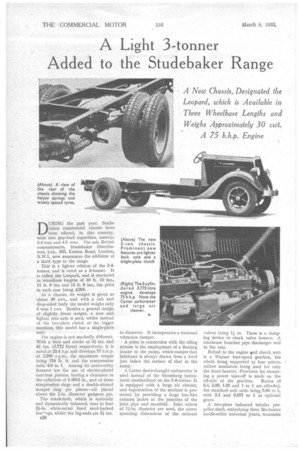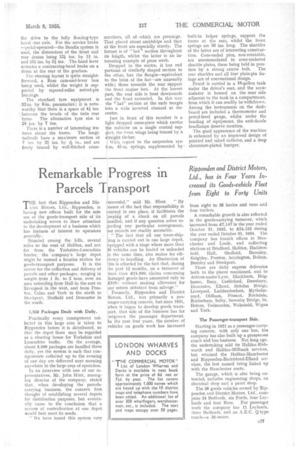A Light 3-tonner Added to the Studebaker Range
Page 58

Page 59

If you've noticed an error in this article please click here to report it so we can fix it.
A New Chassis, Designated the Leopard, which is Available in Three Wheelbase Lengths and Weighs Approximately 30 cwt.
A 75 b.h.p. Engine
DURING the past year, Studebaker commercial chassis have been offered, in this country, with two pay-load capacities, namely, 3-4 tons and 4-5 tons. The sole British concessionaire, Studebaker Distributors, Ltd., 385; Easton Road, London, N.W.1, now announces the addition of a third type to the range.
This is a lighter edition of the 3-4tonner, and is rated as a 3-tonner. It is called the Leopard, and is marketed in wheelbase lengths of 10 ft. 10 ins., 11 ft. 9 ins. and 113 ft. 9 ins., the price in each case being £298.
As a chassis, its weight is given as about 30 cwt., and with a cab and drop-sided body the model weighs only 2 tons 1 cwt. Besides a general design of slightly lower weight, a new and lighter rear axle is used, whilst instead of the two-plate clutch of the bigger machine, this model has a single-plate unit.
The engine is not markedly different. With a bore and stroke of 3i ins. and 44 ins. (3.772 litres) respectively, it is rated at 25.4 h.p. and develops 75 b.h.p. at 3,200 r.p.m., the maximum torque being 154 lb. ft. and the compression ratio 4.0 to 1. Among its noteworthy features are the use of electro-plated Cast-iron pistons, having a clearance in the cylinders of 0.0015 in., and of three compression rings and a double-slotted scraper ring per piston—.-all placed above the I-in. diameter gudgeon pin.
The crankshaft, which is statically and dynamically balanced, runs in four 2,i-in. white-metal lined steel-backed bea-7ngs, whilst -the big-ends are 2* ins.
c36
in diameter. It incorporates a torsional vibration damper.
A point in connection with the oiling system is the employment of a floating intake to the pump, which ensures that lubricant is always drawn from a level just below the surface of that in the s ump.
A Carter down-draught carburetter is used instead of the Strornberg instrument standardized on the 3-4-t000er. It is equipped with a large air cleaner, and vaporization of the mixture is promoted by providing a large box-like exhaust jacket at the junction of the inlet pipe and manifold. Inlet valves of 14.5-,-in. diameter are used, the corresponding dimensions of the exhaust
valves being ILin. There is a damping device to check valve bounce. A crankcase breather pipe discharges well to the rear.
Bolted to the engine #nd clutch unit is a Warner four-speed gearbox, the whole being supported at four points, rubber insulation being used for only the front bearers. Provision for mounting a power take-off is made on the
off-side of the gearbox. Ratios of GA, 3.09, 1.09 and 1 to 1 are afforded, the standard axle ratio being 5.60 to 1, with 5.1 and 6.857 to 1 as optional gears.
A two-piece balanced tubular propeller shaft, embodying three Mechanics needle-roller universal joints, transmits
the drive to the fully floating-type bevel rear axle. For the service brake —pedal-operated—the Bendix system is used, the dimensions of the front and rear drums being in ins. by 11in. and 15iins. by 21. ins. The hand lever actuates a contracting-band brake on a drum at the rear of the gearbox.
The steering layout is quite straightforward, a Ross cam-and-lever box being used, whilst the weight is supported by tapered-roller swivel-pin bearings.
The standard tyre equipment is . 32-in. by 6-in. pneumatics ; it is noteworthy that there is a space of 4-1, ins. ' between the treads of the twin rear ' tyres. The alternative tyre size is 34 ins. by 7 ins.
There is a number of interesting features about the frame. The longitudinals have a maximum section of 7 ins. by 21 ins. by 136 in., and are freely braced by well-flitched cross me-.nbers, all of which are pressings. That placed about amidships and that at the front are especially sturdy. The former is of "hat" section throughout its length, whilst the latter is an interesting example of press work.
Dropped in the centre, it has end portions of similarly shaped section to the other, but the flanges—equivalent to the brim of the hat—are unusually wide ; those towards the rear support the front engine feet. At the lowest part, the rear side is bent downwards and the front extended. In this way the " hat" section at the ends merges into a wide inverted channel at the centre.
Just in front of this member is a light dropped cross-piece which carries the radiator on a single central support, the front wings being braced by .a `..raight tie-bar.
With regard to the suspension sysan, 45-in, springs, supplemented by built-in helper springs, support the frame at the rear, whilst the front springs are 36 ins. long. The shackles of the latter are of interesting construction. Cone-ended pins, non-rotatable, are accommodated in cone-socketed shackle plates, these being held in position by a strong centre bolt. The rear shackles and all four plain-pin fixings are of conventional design.
Petrol is carried in a 16-gallon tank under the driver's seat, and the accumulator is housed on the near side adjacent to the tank in a compartment, from which it can readily be withdrawn. Among the instruments on the dashboard are included a thermometer and petrol-level gauge, whilst under the heading of equipment, the anti-dazzle headlamps deserve mention.
The good appearance of the machine is enhanced by an improved design of pointed and raked radiator, and a deep chromium-plated bumper.














































































































